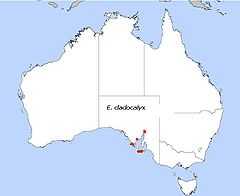Eucalyptus cladocalyx
| Sugar gum | |
|---|---|
 | |
| Scientific classification | |
| Kingdom: | Plantae |
| (unranked): | Angiosperms |
| (unranked): | Eudicots |
| (unranked): | Rosids |
| Order: | Myrtales |
| Family: | Myrtaceae |
| Genus: | Eucalyptus |
| Species: | E. cladocalyx |
| Binomial name | |
| Eucalyptus cladocalyx F. Muell. | |
 | |
| E. cladocalyx, field distribution | |
The Sugar Gum (Eucalyptus cladocalyx) is a eucalypt from South Australia. It is found naturally in three distinct populations - in the Flinders Ranges, Eyre Peninsula and on Kangaroo Island. Sugar Gums from the Flinders Ranges reach up to 35m in height and have the classic "gum" habit - with a straight trunk and steep branches occurring about halfway up. Each main branch ends with its own little canopy. These are commonly cultivated as farm windbreaks and for timber. However, Eyre Peninsula and Kangaroo Island trees are much shorter and often have crooked trunks.
E. cladocalyx has no close known relatives within the Eucalyptus genus. It is notable for its mottled colourful yellow to orange bark, strongly discolourous leaves and inflorescences grouped on leafless branchlets inside the tree crown.
The old bark is smooth and grey, shedding in irregular patches to expose the fresh yellowy-brown bark. Flowers are creamy-white in summer. The capsules are barrel to urn shaped.
References
- Holliday, I. A field guide to Australian trees (3rd edition), Reed New Holland, 2002
- Cronin, L. Key Guide to Australian Trees, Envirobook, 2000
- Rawlings, M. Regional allozyme divergence in Sugar Gum, Eucalyptus cladocalyx, 2005, Centre for Plant Biodiversity Research